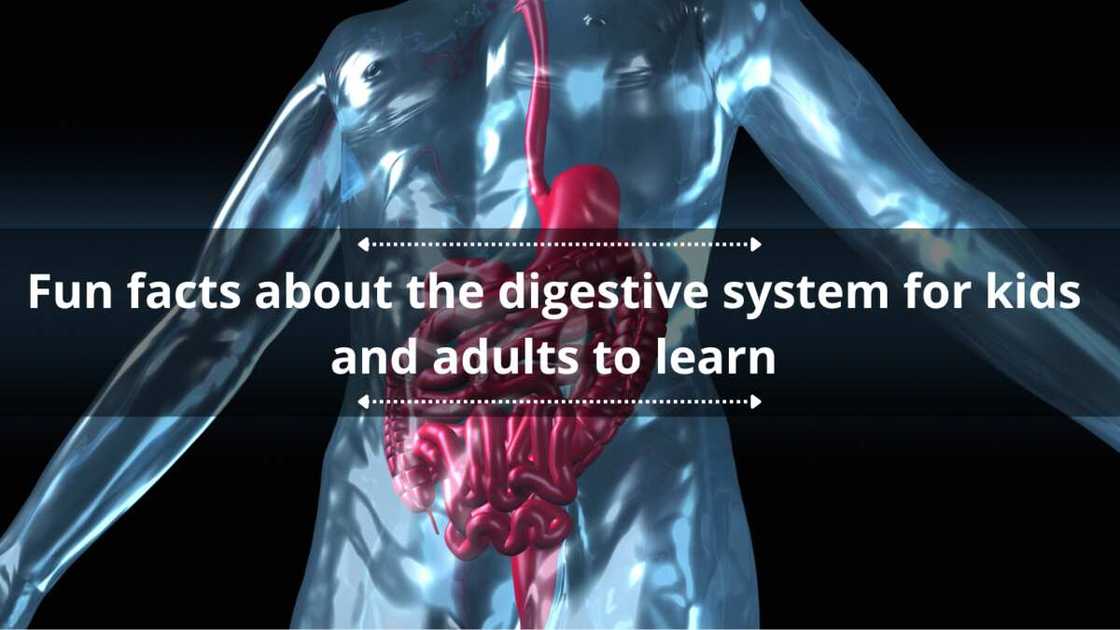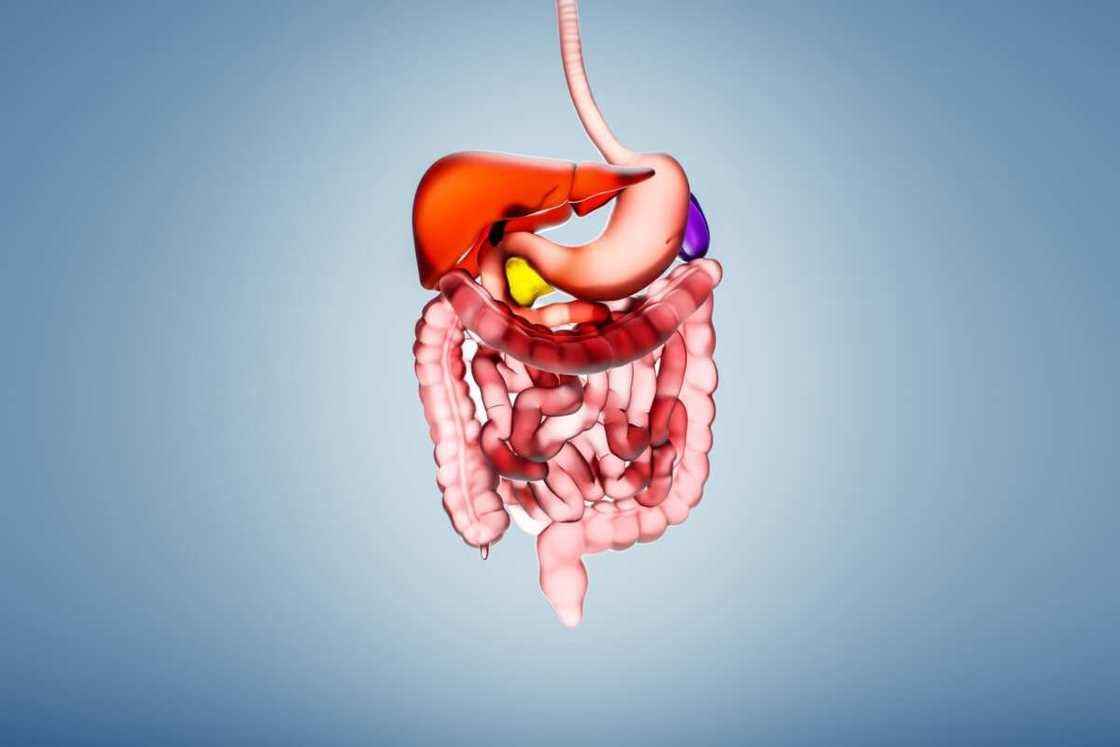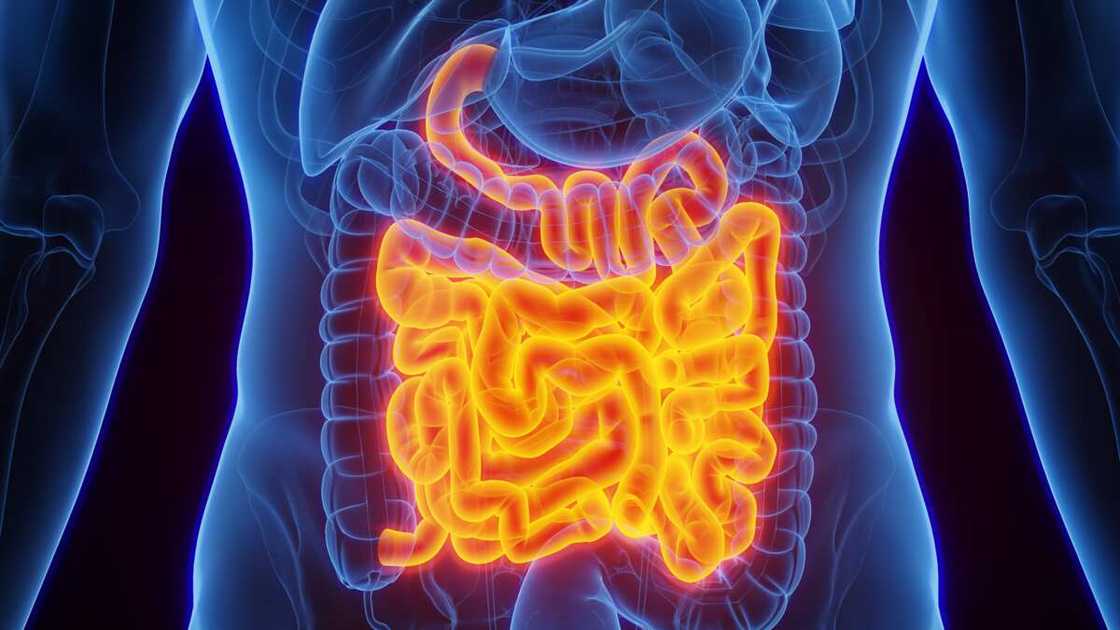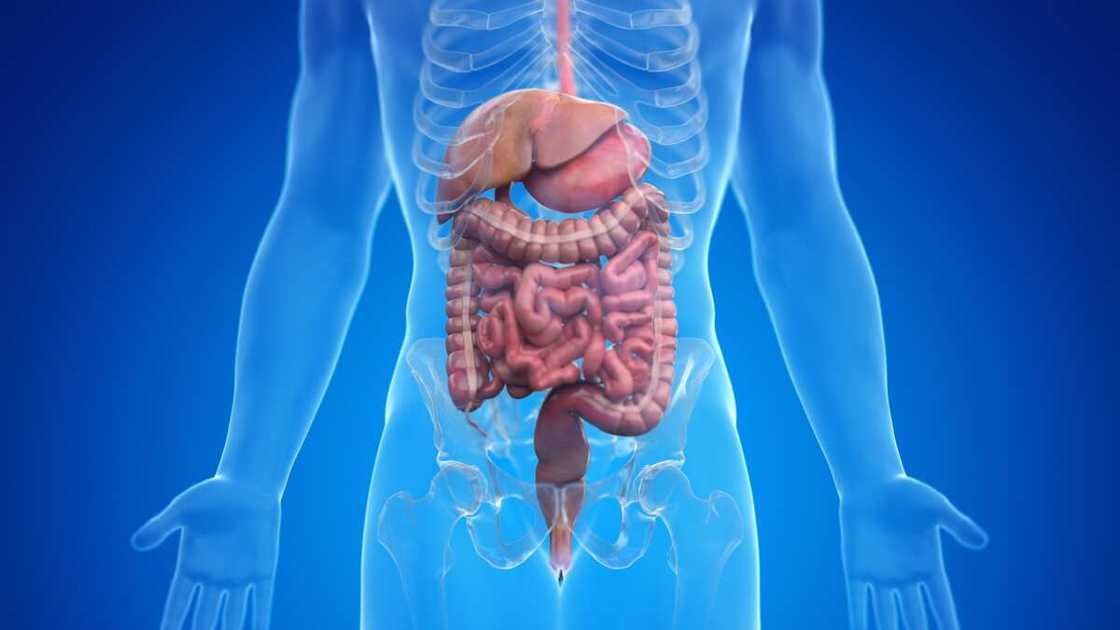25 fun facts about the digestive system for kids and adults to learn
A human digestive system is a group of connected organs that perform different functions. It helps break down food into smaller components until they can be absorbed and assimilated into the body. Discover some fun facts about the digestive system that you may not have known.

Source: Getty Images
TABLE OF CONTENTS
- Fun facts about the digestive system
- 1. There are 9 major organs in digestion
- 2. Digestion takes around six to eight hours
- 3. Fat content takes longer to digest than carbs
- 4. Digestion can work against gravity
- 5. The stomach makes about 1.5 to 3 litres of gastric juice
- 6. Digestion is a 6-step process
- 7. A person produces 1500ml of saliva every day
- 8. Food takes 5–7 seconds to travel in the oesophagus
- 9. The gut-brain axis regulates the digestive system
- 10. The large intestine has four sections
- 11. Water plays a vital role in digestion
- 12. The small intestine can stretch up to 22–23 feet
- 13. The small intestine has three regions
- 14. Fiber is an essential dietary nutrient
- 15. The stomach produces hydrochloric acid to aid in digestion
- 16. The stomach does not do most of the digestion
- 17. The gallbladder stores bile to aid in digestion
- 18. The gut hosts over 400 bacterial species for digestion
- 19. Stomach rumbling makes Borborygmi
- 20. Improper digestion leads to constipation
- 21. The digestive tract is 30 feet long
- 22. The most common digestive issue is bloating
- 23. The small intestine is the most important organ of the digestive
- 24. Digestive enzymes regulate the food temperature
- 25. The surface area of the small intestine is about 250 sq. meters.
- What is the function of the digestive system?
- What are some interesting facts about the stomach?
- What are some cool facts about the intestines?
The digestive system is a long, twisting tube that starts at the mouth, goes through the oesophagus, stomach, small intestine, and large intestine, and ends at the orifice. It breaks down food into simple nutrients such as carbohydrates, fats, and proteins.
Fun facts about the digestive system
The digestive system serves as a route for the ingestion, digestion, breaks down and assimilation absorption of food and water, and removal of waste products from the body. What is unique about the human digestive? Here are some fascinating facts you should understand about your digestive system.
1. There are 9 major organs in digestion
The digestion process is very complex, and several organs come into play. The digestive system has nine organs: the mouth, oesophagus, stomach, pancreas, liver, gallbladder, small intestine, large intestine, orifice. Each organ has a specific role in the digestion process.
2. Digestion takes around six to eight hours

Source: Getty Images
After eating, food takes about six to eight hours to pass through the stomach and small intestine. It then enters the large intestine for further digestion, water absorption, and, finally, elimination of undigested food. Generally, food takes 24 to 72 hours to move through your digestive tract. However, the exact time depends on the amount and types of foods you have eaten.
3. Fat content takes longer to digest than carbs
The human body takes about 6 hours to digest a meal high in fat, whereas it takes only 2 hours to digest a carbohydrate meal. Some carbs are digested quickly so that the brain can use glucose for energy.
4. Digestion can work against gravity
Food does not move through your digestive system through gravity. It uses muscular compressions called Peristalsis. When you eat, the muscles in your oesophagus constrict and relax in a wavelike manner and push food along the oesophagus and into the stomach.
5. The stomach makes about 1.5 to 3 litres of gastric juice
According to the National Institutes of Health (NIH), the stomach produces approximately 1.5 to 3 litres of gastric juice per day, depending on factors such as diet and physiological state. The gastric juice plays a key role in the digestion of proteins by activating digestive enzymes, which together break down the long chains of amino acids of proteins.
6. Digestion is a 6-step process
The digestive system uses mechanical and chemical activities to break food down into absorbable substances during its journey through the digestive system. The digestion process includes six activities: ingestion, propulsion, mechanical or physical digestion, chemical digestion, absorption, and defecation.
7. A person produces 1500ml of saliva every day
The average person produces 1500ml of saliva per day. Salivary glands in the mouth produce saliva. It is slightly acidic, with a pH of about 6.8. The enzymes found in saliva are essential to begin digestion of dietary starches and fats.
8. Food takes 5–7 seconds to travel in the oesophagus

Source: Getty Images
Transport of material through the oesophagus takes approximately 5 to 7 seconds. This time can vary slightly depending on factors such as the consistency of the food, how well you chewed it, and individual differences in anatomy and physiology.
9. The gut-brain axis regulates the digestive system
The gut-brain axis is the two-way biochemical signalling that takes place between the gastrointestinal tract and the central nervous system. It allows the brain to influence intestinal activities, including the activity of functional immune effector cells. The gut influences mood, cognition, and mental health.
10. The large intestine has four sections
The large intestine, also known as the large bowel, is the last part of the gastrointestinal tract and of the digestive system in tetrapods. It is divided into four main regions: the cecum, the colon, the bowel, and the orifice. Its functions include absorbing water and electrolytes, producing and absorbing vitamins, and forming and propelling faeces toward the bowel for elimination.
11. Water plays a vital role in digestion
Water is important for healthy digestion. Water prevents digestion conditions such as constipation and indigestion. Proper hydration also supports regular bowel movements and helps prevent digestive discomfort.
12. The small intestine can stretch up to 22–23 feet

Source: Getty Images
The small intestine is a long tube-like organ that connects the stomach and the large intestine. The small intestine can stretch out to around 22-23 feet, whereas the large intestine is only four feet long. It folds many times to fit inside the abdomen.
13. The small intestine has three regions
The small intestine has three parts: the duodenum, jejunum, and ileum. It helps digest food from the stomach and absorbs nutrients, including vitamins, minerals, carbohydrates, fats, proteins, and water, from food so the body can use them.
14. Fiber is an essential dietary nutrient
Fibre is an essential dietary nutrient for the human body. Fibre helps move food through the digestive tract, preventing constipation and abdominal pain. Fibre is mainly a carbohydrate. It also keeps the digestive system healthy.
15. The stomach produces hydrochloric acid to aid in digestion
The stomach lining is made of smooth muscle and epithelial cells that contain cells called parietal cells. These cells secrete HCL or hydrochloric acid and other enzymes. The primary function of hydrochloric acid in the stomach is to create an acidic environment, which aids in the breakdown of food and the activation of digestive enzymes.
This acid also protects against harmful microorganisms entering the digestive system through ingested food. An imbalance in the stomach acids can cause bloating, burping, nausea, or acid reflux.
16. The stomach does not do most of the digestion
Even though most of the food is broken down in the stomach, it is not the site of most digestive processes. Most chemical digestion occurs in the small intestine, where absorption and assimilation occur.
17. The gallbladder stores bile to aid in digestion
The gallbladder stores bile, a thick liquid produced by the liver and used during digestion. When eating, the gallbladder's thin, muscular lining squeezes bile into the small intestine through the main bile duct. The more fat you eat, the more bile the gallbladder injects into the digestive tract.
18. The gut hosts over 400 bacterial species for digestion

Source: Getty Images
The human gut is the richest ecosystem of bacteria in the body, consisting of an estimated 400 bacterial species. These bacteria play crucial roles in various bodily functions, including digestion, immune system regulation, and the production of essential vitamins.
19. Stomach rumbling makes Borborygmi
Borborygmi refers to the characteristic growling or rumbling sounds that the stomach and intestines make as food, fluids, and gas pass through them. These sounds occur when the stomach has contents but are louder when the stomach is empty, as there is nothing to hide the sound.
20. Improper digestion leads to constipation
Constipation is another common symptom of improper digestion in the human body. It occurs when bowel movements become less frequent and stools become difficult to pass. It happens most often due to changes in diet or routine or inadequate fibre intake.
21. The digestive tract is 30 feet long
Another fun fact about the digestive system for kids is that the digestive tract is about nine meters (30 feet) long. It begins in the oral cavity and is followed by the oesophagus, stomach, duodenum, small intestine, large intestine, colon, and bowel.
22. The most common digestive issue is bloating
One of the most common digestive issues is bloating. A bloated stomach occurs when the stomach or intestine fills with air or gas, causing physical discomfort, stomach pain, nausea, or poor appetite. You may also burp or belch frequently or have abdominal rumbling or gurgling.
23. The small intestine is the most important organ of the digestive
The small intestine is the most important organ of the digestive system because it carries the major digestion and absorption of digestion food. It receives two digestive juices, the bile and the pancreatic juice, in the duodenum. These two juices virtually complete the digestion of starch, proteins and carbohydrates.
24. Digestive enzymes regulate the food temperature
Digestive enzymes, such as amylase, lipase, pepsin and trypsin, help in the chemical digestion of food by breaking down complex food particles into simpler ones. High temperatures generally speed up a reaction, and lowering temperature slows down a reaction.
25. The surface area of the small intestine is about 250 sq. meters.
The small intestine's surface area is approximately 250 square meters (around 2,700 square feet). This is due to the presence of numerous folds, villi, and microvilli. These structures increase the surface area, enhancing the small intestine's ability to absorb nutrients efficiently.
What is the function of the digestive system?
The digestive system breaks down food into nutrients the body can absorb and use for energy, growth, and cell repair. It also eliminates waste products from the body.
What are some interesting facts about the stomach?
Some interesting facts about the stomach are that it produces hydrochloric acid, secretes pepsin, an enzyme that starts protein digestion and is lined with a thick layer of mucus.
What are some cool facts about the intestines?
The intestines have their own nervous system, called the enteric nervous system. Most nutrient absorption occurs in the small intestine, about 20 feet long, and the large intestine, about 5 feet long.
When exploring fun facts about the digestive system, it's essential to understand how this complex series of organs works. Food and liquids pass through the mouth, pharynx, oesophagus, stomach, small intestine, large intestine, bowel, and orifice, transforming into absorbable forms.
Legit.ng recently published an article about X-ray fish facts. The X-ray fish is a unique breed found in the South American region. This breed has other names, such as water goldfinch, golden Pristella tetra, or X-ray tetra.
The X-ray fish type comes from the Pristella maxillaris species. They are known for having see-through skin that resembles an X-ray. Discover some interesting facts about X-ray fish you should know.
Source: Legit.ng












